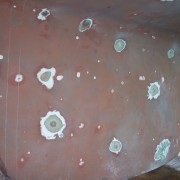Get the 411 on Boat Blisters
For many people, blisters on boats are a mystery. I hope massage helps to answer some of your questions.
First of all, there are two types of blisters: Paint and Osmotic.
Osmotic blisters are basically caused by water passing through the hull into the fiberglass. Water molecules are very small and can travel through most things, even metal, if given enough time. This is why undercoats (epoxies and other systems) are important. Undercoats help stop water from traveling into the fiberglass of your boat. As water travel through the fiberglass, a blister is formed. According to the U.S. Coastguard, blisters are not considered a structural problem until they reach the size of a quarter. Frankly, I have never heard of a boat sinking due to blisters.
Blisters are sometime hard to detect underwater. This is due to limited lighting and the fact that you cannot see down the line of the boat, only a “face on” view. Also, when a boat is out of the water, the hull heats up and blisters show up more predominantly. Wood and Metal hull boats do not get Osmotic blisters; this is mainly a fiberglass boat problem.
Some boats have no paint and as to date, don’t have any blisters. We don’t know the exact reason, but I believe that this is due to the gel coats and fiberglass layup. It is expensive to fix blisters. If you only have a few, you can dig them out and fix them. If there are many, you can have the hull stripped and rebuilt. Or, you can leave them alone or let the next owner deal with them. Divers are not the cause of blisters, and often times do not report them, due to limited lighting underwater and the slow process in which they grow. Blisters sometimes take years to show up. If you are concerned about this problem an in-water survey can be arranged.

